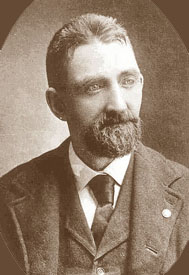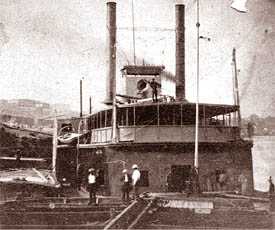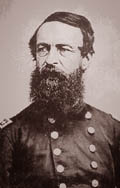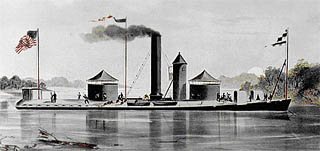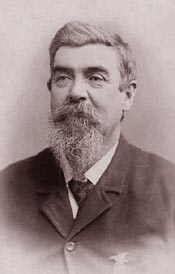
|
|
Patrick Hanley
From the 28th Wisconsin to the U.S. Navy Patrick Hanley was born on November 1, 1844 in Roscommon County, Ireland. While there is no documentation to show the fact, it is believed he may have come from the village of Ballykilcline. Patrick's parents, Michael and Mary (Gill) Hanley, immigrated to the U.S. in or around 1855 when Patrick was about 11 years old. He must have lived for some years in Sullivan County, New York because a sister, Helen "Nellie" Hanley was born there in 1858. By the early 1860's they had settled in Monches, a small village in between North Lake and Hartford, Wisconsin off Highway 83.
Patrick was initially on the receiving ship, the U.S.S. Clara Dolson, but probably only to transit to his actual ship a week later, the U.S.S. Covington, a tin-clad gunboat of the Mississippi Fleet. This was his ship for the next 11 months. I have read the captains logs (one good thing about the Navy was the regular documenting of daily events) for the duration of his naval service. While most of it was mundane and the cruising up and down the Mississippi without event, there were some interesting things ...
July 6, 1863 - Patrick finds out Wisconsin 28th company H is nearby his port at St. Helena, Arkansas. He makes contact with some people in his regiment, but does this unofficially fearing he will be put in the brig for desertion. August 7, 1863 - Helena, AK; Transferred armaments and supplies from sinking USS Paw Paw; Guarded her. May 4, 1864 - This was written up in various military books including the authoritative book on the Navy in the Civil War: The Naval History of the Civil War, by Admiral David D. Porter. The U.S.S. Covington was part of the Red River Campaign. The Union was trying to drive up the Red River to reach Shreveport, LA and gain access to Texas. Partly this was to gain supplies of cotton, but also to further divide the Confederacy. The following is the narrative of the battle: "A large steamer, the Warner was loaded with cotton at Alexandria, LA and dispatched with 400 soldiers for New Orleans. The Admiral (Porter) asked for a convoy and was sent the two best gun-boats he could spare that were below the "Falls" (in Alexandria), the Signal and the Covington. There was a minor skirmish with some Confederate infantry firing from the river bank and one man was killed on the Warner. The fire of the Covington soon drove off the Confederates, but this was only an earnest of what was to follow. The next morning (May 5), on arriving at Dunn's Bayou, a Confederate unit (identity unknown) had passed around the Union army at Alexandria with 6000 men and 25 pieces of artillery. The gunboats fought like hell for five hours, with their steam pipes cut and boilers leaking. Finally, Lt. Lord landed the Covington on the far bank, offloaded his crew and set fire to his ship. The Signal had too many wounded to get away and fell into the hands of the Rebels, who took her guns and sunk her as an obstruction. Most of the guns, Porter claimed, which sank the Union ships were captured from the Union army at Pleasant Hill!"
You can imagine these men fighting against unbeatable odds, but never giving up until their rudder was disabled and they could no longer navigate. There were 74 in the crew and 42 were killed. (I visited this area in May 2003 and saw Alexandria and tried to find Dunn's Bayou. No one knew where it was, but from the descriptions, I got to where I thought it might be. With many of the Corps of Engineers flood control projects, the Red River has changed course and locations may not be the same. - The Author) Patrick and the survivors from the Covington escaped over land and reconnected with Union forces near Alexandria. Patrick ends up on the U.S.S. Fairy for the next two months. He is discharged, but re-enlists (I believe he was a coxswain, the person who steers the boat ... an advancement in rank) and is assigned to a new gunboat, the Kickapoo.
March 29, 1865: Kickapoo is involved in the siege of Mobile Bay and rescues the crew of the Osage, which was sunk by a torpedo. July 25, 1865 - Patrick Hanley on U.S.S. J.P. Jackson August 22, 1865 - Patrick Hanley Transfers to Aroostock going from New Orleans to Pensacola, FL. September 7, 1865 - Patrick Hanley departs on Aroostook for Philadelphia Navy Yard. September 18, 1865 - Hanley and Aroostook arrive at Philadelphia Navy yard for repairs. October 15, 1865 - Patrick Hanley discharged from Navy in Philadelphia (listed as Milwaukee too). For years Patrick was troubled by his apparent listing as a deserter and this came to issue in 1896 when he applied for military benefits and to live in the Wisconsin Veterans Home in King, Wis. Patrick provided documentation that actually went to the Department of the Navy and then to Congress which removed the desertion charges and provided him with an honorable discharge in 1898. In the committee hearings the following was transcribed:
July 8, 1898 Act of Congress (private no. 384) Approved July 1, 1898 honorable discharge given. May 20, 1907 Patrick passed away in Waupaca. He is buried at the cemetery at the Veterans Home in Waupaca next to his mother Mary. Biography generously shared by by Patrick Hanley's great-great grandson David Bunzel.
| ||||||||||
|
Last Updated:
Webmaster: |
